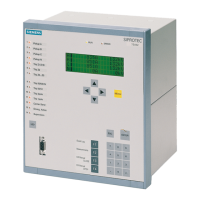2 Functions
408
7SD5 Manual
C53000-G1176-C169-1
Breaker Tripping
Alarm Suppression
While on feeders without automatic reclosure every trip command by a protection
function is final, it is desirable, when using automatic reclosure, to prevent the opera-
tion detector of the circuit breaker (transient contact on the breaker) from sending an
alarm if the trip of the breaker is not final (Figure 2-180).
For this purpose, the signal from the circuit breaker is routed via a correspondingly al-
located output contact of the 7SD5 (output alarm „CB Alarm Supp“, No. 563). In the
idle state and when the device is turned off, this contact is closed. Therefore an output
contact with a normally closed contact (NC contact) has to be allocated. Which contact
is to be allocated is dependent on the device version. Refer to the general views in the
Appendix.
Prior to the command, with the internal automatic reclosure in the ready state, the
contact is opened so that no signal from the circuit breaker is forwarded. This is only
the case if the device is equipped with internal automatic reclosure and if the latter was
taken into consideration when configuring the protection functions (address 133).
Also when closing the breaker via the binary input „>Manual Close“ (No 356) or via
the integrated automatic reclosure the contact is interrupted so that the breaker alarm
is inhibited.
Further optional closing commands which are not sent via the device cannot be taken
into consideration. Closing commands for control can be linked to the alarm suppres-
sion via the user-defined logic functions (CFC).
Figure 2-180 Breaker tripping alarm suppression
If the device issues a final trip command, the contact remains closed. This is the case,
during the reclaim time of the automatic reclosure cycle, when the automatic reclosure
is blocked or switched off or, due to other reasons is not ready for automatic reclosure
(e.g. tripping only occurred after the action time expired).
www . ElectricalPartManuals . com

